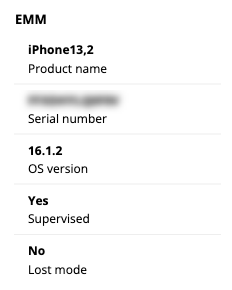VSA 10 MDM: Supervised vs. non-supervised devices
In the context of Apple MDM, devices can be categorized as either supervised or non-supervised. Each category offers different levels of control and management capabilities. VSA 10 supports both types, so it's important to understand their differences.
| Supervised devices | Non-supervised devices |
|---|---|
| Supervised devices are those with enhanced management capabilities granted by an organization, allowing comprehensive control over settings and applications. They are typically used with devices the organization owns. | Non-supervised devices are usually personally owned and have opted into management with user consent, offering basic management features like software updates and security settings while maintaining more user privacy. |
| Features | |
|
|
About supervised mode
Supervised mode provides more options to manage the device, such as restarting, shutting down, and enabling or disabling lost mode. The Play Lost Mode Sound will work only for supervised devices.
macOS devices are always supervised. iOS and iPadOS devices are supervised if they have been enrolled via USB with the Supervised option checked. You can find out if a device is supervised in the Asset Info section of the device details pane:



